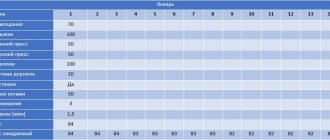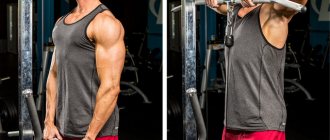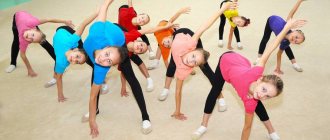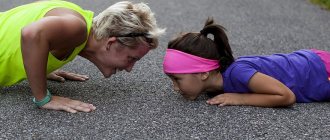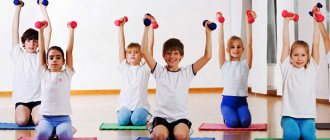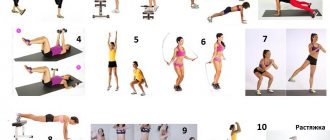Whether you're working on your weight or just want to live a more active lifestyle, your smartphone can be used as a personal trainer, in addition to playing music and communicating on social networks.
We have prepared for you a review of the best training apps, which include everything you need, from detailed step-by-step instructions for home to the ability to create your own program for the gym. We advise you to test several of them and choose the most suitable one.
Freeletics Bodyweight
Freeletics includes hundreds of workouts that cover a variety of muscle groups and fitness levels. All exercises are designed to work with your own weight only and are provided with step-by-step instructions. Paid users get access to future workouts, performance analysis, and a 2x2 training mode that requires very little space to practice.
Available for Android and iPhone.
Features of training preparation
Developing a training program is a complex process, not free volleyball, and it takes into account a number of factors:
- the number of muscle groups worked in one workout;
- number of exercises per group;
- development in one exercise;
- repetitions in one exercise;
- duration of rest between approaches;
- weight and endurance.
The speed for all exercises for girls and men is slow, with special concentration in the lifting and lowering phase. Duration is a maximum of an hour, provided there is no steroid nutrition. Training stress should not be extended over time, since such a schedule leads to a long recovery. This occurs due to the release of catabolic steroids into the blood, which reduce the volume of anabolic steroids. The body stops producing testosterone, which leads to weight loss rather than weight gain.
Select reps and weight
Almost all factors in drawing up a training plan are interconnected, for example: periodization with the weight of the projectile. Increased weight cannot be lifted many times, and classic bodybuilding requires 6-12 repetitions in one approach. With more weight, failure will occur earlier, so maximum hypertrophy will not be achieved.
Alexander Shestov
TRX Certified Trainer
Ask a Question
Extending your rest in the gym is not recommended. Three-minute breaks are only allowed in home powerlifting classes. In addition, a shortened rest will allow you to complete all the exercises in the allotted time.
Seven
There are many seven-minute workout programs available today. However, one of the best is Seven from Perigee. It suggests exercising 7 minutes a day for 7 months using a special tracker to track your results.
All exercises are aimed at working the entire body, and special 3D manuals will help you perform each of them correctly. For a little fun, you can challenge your friends for a little friendly competition. The paid 7 Club will provide customized lesson plans for $10 a month.
Available for Android and iPhone.
Classification and types of training sessions[edit | edit code]
The article presents three practically important classifications of individual training sessions from the point of view of their (1) organization, (2) tasks and (3) load level.
Types of classes depending on the characteristics of their organization[edit | edit code]
There are many possible forms of training organization that are used in world coaching practice; they can be divided into three main categories (see Table 1)
As can be seen in Table 1, each form of organization and its corresponding type of training has its own specific advantages, as well as limitations. Group training
how organizational forms allow coaches to manage maximum loads. This type is most often used during training camps and so-called centralized training, when athletes of the same level train together. This is the predominant form in team sports and combat sports. It should be noted that long-term training using only group training has very clear psychological and neurophysiological limitations. When athletes train with high motivation, in conditions of competition and prolonged emotional stress, this can lead to excessive and chronic arousal of the central nervous system and, ultimately, to emotional exhaustion. This is why it is important to find a harmonious combination of strictly programmed team training within this and other types of training sessions.
Table 1. Classification of training sessions depending on their organization
| Type | Form of organization | Possible benefits |
| Group training | Collectively executed workload according to a strict or flexible plan | Team spirit, emotionality, use of competition and partnership |
| Scheduled lesson under the guidance of a trainer | Focusing the attention of the coach and athlete on the correct details of performing the load / movement technique | |
| Individual training | A programmed activity performed by the athlete independently | Reduces emotional stress, training is carried out at a convenient time and in a convenient place |
| Free or almost free workout without a strict plan | Unleashing the athlete's initiative, independent regulation of the load level | |
| Mixed training | Combination of the first two organizational forms | Diversity, the ability to combine the advantages of other forms |
Individual training
are used to implement both very ambitious and strictly programmed plans (as in the group type mentioned above), and for freer and less stressful preparation. Their use is more suitable for individual sports than for team and martial arts. In some sports, such as figure skating, individual training constitutes almost the entire preparatory program for highly skilled athletes. However, even in team sports they contribute to the overall training program. In football, basketball, ice hockey, etc. Pre-season training of world-class players is their personal responsibility. World-class stars must find their own means, a coach to solve their problems and fit into an appropriate training schedule, which, as a rule, is individual.
Example
.
A highly professional and successful football player aged 30-33 regularly completed a month-long specialized training cycle at the beginning of the season (the mesocycle was dedicated to the development of maximum speed).
For this purpose, he hired a highly qualified coach (specialized in athletics sprinting), who planned, directed and controlled his training process. The training cycle consisted of individual training conducted under the guidance of a coach and partly by the athlete himself. This specialized work allowed him to maintain a high level of top speed despite the difficulties encountered due to his age and previous injuries (Mark Tunis, personal communication to the author). Mixed workouts
often used in many sports. In individual sports, the individual portion of training is typically used to improve technique, recovery, and relaxation; in team sports and combat sports, it typically focuses on conditioning training, technical skill acquisition, and relaxation.
Another example
.
The legendary Edson Arantes Do Nascimento (Pelé) said in an interview filmed for a documentary: “I often stayed after training and improved my shots, passes and heading” (“Pelé Forever”, directed by Anibal Massaini Neto, Brazil, 2004).
It would be fair to say that it was the combination of teamwork and individual excellence that made this sports genius so remarkable. Many factors determine the ratio of training types used. These are sports specifics, training facilities, the number of athletes under the tutelage of a coach, the availability of individual devices for self-monitoring (such as heart rate monitors, stopwatches, etc.), the possibility of combining exercises performed indoors and outdoors within one training session, as well as features each athlete and his preferences in terms of working in groups or individually.
Classification of occupations depending on the tasks performed in them[edit | edit code]
Sports practice requires that we differentiate training depending on the prevailing objectives. Table 2 presents the classification of training sessions depending on the tasks performed in them.
Table 2. Classification of training sessions depending on the tasks performed in them
| Type | Goals | Notes |
| Air-conditioned training | Improving physical qualities, general and/or sport-specific motor readiness | This type of training session is predominant in many sports and is often combined with technical tasks. |
| Technical training | Acquiring new technical skills, improving movement techniques | This type of training solves the problem of improving movements and requires assessment of indicators of its quality |
| Tactical or technical-tactical training | Acquiring new tactical (or technical-tactical) skills, improving individual and/or team tactics | Physical and theoretical tasks can be combined, theoretical classes can be included additionally |
| Control training | Assessing the level of development of an athlete's abilities | Sport-specific competitive conditions can be simulated |
| Combined training | Development of various physical qualities in combination with solving various problems | Possibilities: 1) combination of different types of training; 2) combining different tasks when performing certain exercises |
Conditioning training
, dedicated to the development of general and sport-specific motor abilities, form an important part of training programs in many sports. Very often this type of training session involves technical work, although not too strenuous. Such training can use various organizational forms, such as group or individual, conducted by the coach or the athletes themselves.
Technical training
, as a rule, require more attention and organizational efforts. The process of mastering new technical skills (or improving movement technique) must be assessed in real time and immediately adjusted in subsequent attempts. Of course, such work should be carefully monitored by a trainer or specially attracted experts. However, many trainers have little technical knowledge, and there are not many experts in this area. Therefore, it is important for them to search for reliable sources of such information (Yessis, 2006). Individual training conducted by the athletes themselves is not suitable for this purpose.
Thus, an additional factor influencing the level of difficulty of technical training is the use of visualization tools, such as video recordings, to provide athletes with objective information about the quality of performance of a competitive exercise and the significant details of correct technique. It should be emphasized that mastering movements (improving movement techniques) requires high mobilization of the cognitive and coordination abilities of athletes. Therefore, this type of training puts a significant load on the central nervous system, which should be taken into account when planning the training process.
Tactical or technical-tactical training
focus primarily on acquiring new tactical skills and improving individual and/or team tactics. Another function of such training is to combine tactical and technical skills, which is extremely important for successful competitive performance. Partial tactical training can be carried out in conjunction with theoretical and psychological preparation. However, much of this work must be planned and implemented carefully in sport-specific conditions where stressful competitive situations can be partially simulated. This type of training is more typical for team sports and martial arts, where the importance of tactical skills is relatively higher.
Control training
are intended mainly to assess the level of development of the physical and technical abilities of athletes, i.e. specially selected components of preparedness (sport-specific strength or endurance), and can be carried out in artificially created conditions with maximum approximation to the conditions of the upcoming competition. Since these training sessions require maximum effort from athletes, they must be carefully organized, provided with appropriate equipment, located in suitable environmental conditions, and must be carried out with the support and close cooperation of the coaching team.
Combined workouts
are devoted to the development of several sporting abilities (for example, physical and technical or physical and technical-tactical) within one lesson. So, the first part of the training can be devoted to mastering the movements, while the second - conditioning training. In the same way, control training can be accompanied by conditioning training. Another variant of combined training combines the solution of various training tasks in special exercises specific to the sport. This approach involves the simultaneous development of sport-specific motor abilities and the improvement of the corresponding technical skill. Such training means of double combined effect are called conjugate exercises. Typically, such coupling is ensured when performing exercises in specially organized conditions, when the speed of movement is reduced due to external resistance or increased due to special devices (Maglischo, 1992). It can also be realized through the use of specialized strength exercises.
Example
.
Exercises with additional resistance are widespread and especially popular in cyclic sports such as running, swimming, kayaking and canoeing, rowing, etc. Typically, such exercises are aimed at improving the skill of applying force within the existing sport-specific technical scheme and increasing the level muscular endurance. The option with external resistance, which artificially reduces the speed of movement, is usually implemented using relatively inexpensive equipment. It is assumed that exercises with artificially increased speed of movement make it easier for the athlete to reach high-speed modes and often help to overcome the so-called “speed barrier”. The combined effect of such exercises is to improve sport-specific technical skill, as well as increase maximum speed or sport-specific speed endurance.
Classification of activities depending on their goals[edit | edit code]
From the point of view of analyzing the planning of the training process and the implementation of these plans, differentiation of training sessions by load is of particular importance. For practical purposes, it is necessary to list the three main functions of a training session: development, maintenance and recovery. The correct load level should correspond to these goals. In fact, each training plan is a specific combination of these types of activities: some activities are designed for development, others are necessary to maintain certain abilities at an already achieved level; and special classes are planned for recovery. Therefore, classifying the training load depending on the goals of the lesson makes practical sense. Table 3, based on this classification by Zatsiorsky (1995), presents a quantitatively ranked scale (from 1 to 5) of training sessions, in which rank 1 corresponds to the lightest load and 5 to the heaviest.
Table 3. Classification of training loads (quantitative scale) depending on the goals of their implementation
(no Zatsiorsky, 1995; revised by Issurin, 2003)
| Goal of training | Training load level | Recovery time , h | Load Estimation , rank |
| Development | Limit | > 72 | 5 |
| Big | 48-72 | 4 | |
| Essential | 24-48 | 3 | |
| Maintenance | Average | 12-24 | 2 |
| Recovery | Small | < 12 | 1 |
The training load-related aspects of this classification require further clarification in terms of the length of time desired for full recovery. The main limitation concerns training associated with significant psychological and neurophysiological stress. The classification presented above uses the time required to fully recover as an objective indicator of stress level. This approach is applicable to exercises for strength, power, endurance, speed, etc. Workouts that require a high level of coordination and workouts that cause increased emotional stress usually require less time to fully recover.
However, it is not always possible to select integrative objective markers and indicators based solely on the duration of recovery. However, the generally accepted approach involves a series of several training sessions that corresponds to the desired level of load, assessed by pedagogical and sport-specific indicators. For this purpose (to qualify the level of training load), the widely used Borg scale (Borg, 1973), which assesses individual perception of load, can be applied (Table 4).
Table 4. Determination of the level of training load using the Borg scale (Borg, 1973), assessing its individual perception
(edited by the author)
| Level of individual load perception | Verbal load assessment | Type of workout |
| 6 7 | Very, very light | Restorative |
| 8 9 | Very light | |
| 10 11 | Dying | |
| 12 | Heavy | Supportive |
| 13 | ||
| 14 | ||
| 15 16 | Heavy | Developmental (significant load) |
| 17 18 | Very heavy | Developmental (heavy load) |
| 19 20 | Very, very heavy | Developmental (maximum load) |
Keeping in mind both of the above-mentioned classifications related to training load, we can formulate at least two practically important consequences:
- the level of load in any workout can be determined and quantified. This can provide additional advantages when planning the training process, especially in sports with unmeasurable results (sports games, gymnastics, etc.), and will allow for greater emphasis on specially selected training sessions;
- The use of load-related categorization of developmental, maintenance and restorative training allows for better differentiation and more careful selection of adequate workloads.
Key training sessions[edit | edit code]
The concept of block periodization (BPP)
pays special attention to planning training loads combined into several training sessions. The principle of high concentration requires that training loads be aimed at a minimum number of target qualities. Unlike the traditional approach to the training process, in which the total volume of exercises performed is of paramount importance, CBT proclaims the absolute priority of the total number of developmental training sessions as a key characteristic.
Example
.
A highly skilled canoeist must develop basic aerobic endurance.
For this purpose, he must perform a weekly 40-45 km volume of exercise at a level close to the anaerobic threshold. In accordance with the traditional approach, this mileage can be divided into nine workouts, in which it will be combined with exercises of a different focus (anaerobic glycolytic endurance, strength endurance, maximum speed, etc.). An athlete performing such a program will be constantly fatigued, and the training effect will vary from small to negligible. The concept of block periodization requires a concentration on exercises aimed at target qualities, mainly within the framework of three to four developmental workouts, which cannot be combined with any anaerobic glycolytic tasks. Athletes will sometimes (but not always) feel fatigued after strenuous developmental training, but the training effect will be more favorable.
According to the KBP, the quality of the training process is strictly determined by the quantity and sequence of developmental training. Moreover, some of them must be shock, and their place must be clearly defined during planning. The most important developmental workouts that focus on the current main areas of the training process are called key workouts.
Over time, leading trainers have selected and highlighted certain training sessions that form the peaks of their respective training cycles and focus on the most important tasks and workloads. These peak workouts, referred to above as key workouts, require athletes to be mentally and emotionally focused and willing to work harder than usual.
Example
.
Tim Noakes (1991), a well-known sports physiologist, formulated some training rules based on the experiences of great middle and long distance runners such as Herbert Elliott, Ron Clark and Frank Shorter. The first rule is: “Alternate hard and easy training days.”
This is very close to the coaching concept of core training, which can be expressed as: “Alternate particularly strenuous workouts with less strenuous and easy ones.” The principle of concentration of workload postulated in the CBP should also be applied to a series of several training sessions. The main characteristics of the key workouts are presented in Table 5.
Table 5. Main characteristics and features of key training
| Main characteristics | Peculiarities |
| Target quality | The load in this training cycle is aimed at developing the most important target qualities, usually one goal corresponds to motor readiness, and the other to technical or tactical readiness |
| Mental factor | Athletes must be motivated to perform the training load that determines the effect of the entire training program |
| Exposure time | Key training is planned to be performed at the best time: when athletes have already been exposed to previous loads, but are still not overly fatigued. |
| Load level | Adjusted to meet developmental training requirements or significant, large or extreme |
| Organizational forms | Partnership, collaboration within the group and team spirit are especially desirable |
| Control | Comprehensive and objective recording of relevant information (using tools such as chronometers, heart rate and blood lactate monitors, video equipment, etc.) or the use of visual cues and pedagogical assessment |
As can be seen from Table 5, key training requires special attention in terms of methodological, organizational and psychological support. These training sessions should contain the most effective and productive exercises, since often their results can be used to monitor the training process and to assess the performance potential of athletes.
It is not recommended to use unknown means in key training sessions or create completely new conditions that require preliminary testing. Athletes must focus on the quality of their work; new means and conditions of training can distract athletes’ attention from the specific details of the load being performed and reduce their level of motivation. All job requirements, organizational details and conditions must be clearly explained before the start of the training session. The above is true for any training, but is especially important for the key one.
Sworkit
Sworkit is versatile and incredibly versatile. For each lesson, it randomly generates a new set of exercises. First you need to choose what you want to do: build strength, do yoga, cardio exercises, stretching, Pilates.
Then, after you specify the desired duration, Sworkit will create an individual program for you that will not let you get bored, as is usually the case with regular classes. The premium version provides even more functionality: choice between exercise options, training history, and the ability to monitor progress.
Available for Android and iPhone.
JEFIT
JEFIT.com will appeal to people who want to get into strength training and bodybuilding. It has a large database of training programs sorted by muscle groups. There are detailed instructions, a built-in planner, an exercise log, a progress tracker, numerous timers and synchronization with the profile on the JEFIT website.
Available for Android and iPhone.
Functional and strength training
Fitness also includes types of gym workouts aimed at strengthening and developing muscles. Let's list them:
- Shaping is an excellent technique for strengthening muscles, which is suitable even for untrained people. The exercises are very simple, and the effect is achieved through repeated repetitions. Training can be aimed both at reducing the volume of problem areas and at increasing missing roundness.
- Callanetics is a very popular type of fitness aimed at burning excess fat and strengthening the muscle frame. During training, almost all muscle groups are involved in work.
- Strip plastic is perfect for body correction, especially if you want to get rid of “ears” on the hips. The exercises are mainly aimed at developing leg muscles and flexibility.
- Body Sculpt – provides loads on all muscle groups of medium and high intensity. All exercises must be performed with dumbbells or other objects that serve as weights. Training helps increase strength endurance and make muscles more prominent.
Keelo
Keelo focuses on short, high-intensity interval training that doesn't take up much time but burns a lot of calories. The full range of activities is covered, from bodyweight-only training to basic weights and gym machines. No matter what you have planned, it will only take 7-20 minutes.
Video instructions make it easy, and Apple Health integration lets you share data with other fitness apps. A premium subscription starts at $13 per month and provides additional features such as unlocking all workouts, warm-ups, relaxation exercises, and public chat with like-minded people.
Available for iPhone only.
Selecting a training system and methodology
Interval training
This is a load at the limit, which consists of alternating low and high intensity. Anaerobic exercise is followed by a long period of relaxation. Range: 6–12 intervals. Training time is 20–30 minutes. For example, first 5 minutes of sprinting, then 15 minutes of walking.
Fun fact: Short interval training burns 3-4 times more calories than longer cardio sessions.
This is an ideal solution for preparing for competitions and heavy loads, but after a while such training must be replaced by a more traditional one. Interval training is absolutely not suitable for people with cardiovascular diseases and some other chronic diseases.
Circuit training
The essence of the training is to quickly perform exercises and move “from station to station.” All major muscle groups are worked out in one session. On average, in 45 minutes you need to perform 8-10 exercises, each of which loads a different muscle group (not the one that worked previously). According to reviews, circuit training is a great option for staying in shape when you have limited time to exercise.
Functional training
This workout combines cardio and strength training with your own weight. Suitable for people without physical training, aged people undergoing rehabilitation after injuries, as well as those who want to lose weight and tone their body a little. Functional training is great for developing endurance, but is ineffective for working with proportions.
HIIT workout
The basis of the classes is the alternation of strength and aerobic exercise, as well as static and dynamic exercises without rest. One circuit includes a minimum of four exercises. During exercise, your heart rate often changes from high to moderate, which helps burn fat. These are high-intensity classes, so they are absolutely not suitable for people with heart disease, joint and muscle diseases.
Step training
Principle of training: target - third-party - smaller muscle group. For example, first exercises are performed on the chest (push-ups), then on the shoulders (dumbbell swings), and at the end - dumbbell flyes again to the chest. During exercise there are no signs of thermogenesis - the athlete does not sweat. The training will be appreciated by those who have already developed their technique, but lack intensity.
Volume training
This training is structured as a strength training: basic and isolated exercises, but using supersets and drop sets, that is, performing, for example, two exercises for one muscle group without rest. Number of repetitions: 15–20 times for women and 12–15 times for men. Workout for those who want to be toned and work on their shape without changing weight.
Basic training
Only one muscle group is loaded on one day of the week. The scheme is as follows: first, three basic exercises for the target group (four sets of 15 repetitions), then circuit training for each muscle group, except the one that was worked at the beginning (four circuits of 20 repetitions). An excellent solution for those who are just starting to play sports, as well as athletes after a long break. However, basic training will be useless for those who exercise rarely (1-2 times a week).
When making a choice, consider your goals and health status. Then a combination and periodic change of activities will bring you the greatest benefit.
ASICS Studio
ASICS Studio gives you access to unlimited audio workouts and helps you do a variety of fitness activities such as strength training and cardio. Classes are taught by professional trainers and are accompanied by energetic music, which can be turned off if desired. There are also audio prompts that make it easy to keep track of your pace.
You can download workouts to your phone to view them without Internet access. The app syncs with the Health utility on your iPhone to store your activity data. The app comes with a free 14-day trial, after which you'll need to pay to continue using it.
Available for iPhone only.
Workout Trainer
Skimble's Workout Trainer offers thousands of free workouts with step-by-step video instructions. They will help you quickly achieve any goals - whether you want to have six-pack abs or gain muscle mass.
In addition to built-in workout programs, users can create their own customized workouts and share them with each other. A premium subscription unlocks new features - HD video, more exercises and removal of ads.
Available for Android and iPhone.
Aaptiv
Aaptiv offers audio workouts for a variety of purposes, complete with music playlists. Users can choose from over 2,500 activity options: running, cycling, HIIT, marathon and more. Workouts can be customized for distance, duration, intensity, and calories burned.
Available for Android and iPhone.
Fitbit Coach
Fitbit Coach helps you create a personalized workout plan and diet to get maximum energy throughout the day. If you have a Fitbit fitness tracker, then installing Fitbit Coach on your smartphone is a must.
Fitbit Coach uses the daily activity recorded by the fitness tracker to recommend appropriate exercises for maximum productivity. For example, if you indicate that the load today was weak, then next time you will receive a more difficult task. Fitbit Coach offers hundreds of workouts, but you'll have to pay $8 a month to get it.
Available for Android and iPhone.
General principles of training speed-strength qualities in cyclic sports
The implementation of targets for speed-strength training of athletes is ensured by compliance with the following principles.
Model characteristics of speed-strength readiness must correspond to the spatio-temporal parameters of competitive activity.
Optimization of quantitative relationships and time transitions from nonspecific exercises of a speed-strength nature to specific exercises corresponding to competitive activity in the kinematics of movements.
The volume and direction of speed-strength training work are determined by the biological characteristics of the athlete (the ratio of muscle fibers of different types, substrate-enzyme support, etc.).
Training work should be aimed at using the energy of elastic muscle deformation accumulated in the yielding phase of movement and increasing the efficiency of muscle work.
In the process of operational management of the training of athletes in speed-strength sports, a systematic approach is implemented through the consistent achievement of intermediate goals.
For the process to be successful, training influences at each stage of preparation must correspond to the plastic and adaptive resources of the body. This approach meets the requirements of consistency, that is, the consistency of its constituent elements. The main ones are: preliminary research of the subject, development of optimal ways to achieve intermediate goals, choice of the magnitude and nature of corrective actions in case of deviations from the goal.
The key point in managing the process of training athletes is the effective diagnosis of conditions, on which the adjustment of intermediate goals and means of influence on the athlete depends. Based on the results of testing subjects under standard laboratory conditions, norms for functional indicators of speed-strength readiness were developed.
The choice of the magnitude and direction of speed-strength training effects is determined by the factor structure of performance, which, in turn, reflects the trend of functional states in training cycles of various durations.
The results of factor analysis performed for contingents with different levels of sports achievements showed that the structure of speed-strength readiness changes as the level of training increases. This permanent process is accompanied by a change in the structure of performance in accordance with the direction of training. In this case, motor activity is accompanied by both compensatory and adaptive changes.
Together they are characterized as sports symmorphosis, that is, a complex of non-hereditary changes under the influence of intense muscle activity.
The system under consideration includes physical, technical, psychological, and ultimately integral readiness.
To a large extent, it depends on the speed and strength capabilities of the athlete. Speed readiness is a set of properties that ensure the performance of motor actions in the minimum time. Forms of manifestation: speed of a simple reaction, speed of a complex reaction, speed of individual motor acts, speed manifested in the frequency of movements.
When assessing special physical fitness, as a rule, the full complex of the above forms of its manifestation is not used, but only that aspect that is most characteristic of the sport. Thus, the speed of individual motor acts is informative in throwing and barbell, and the pace of movements is informative in sprinting.
This dictates the need for a detailed assessment of special physical fitness in a specific sport.
The complex of strength abilities includes: maximum strength, explosive strength, strength endurance. Both classic exercises of weightlifters and exercises that reflect the specifics of a particular sport are used as test exercises when measuring maximum strength. Another type of testing is measuring the maximum force of individual muscle groups using special devices.
For most speed-strength sports, the most informative characteristic is explosive strength, which is determined by the ratio of the magnitude of the effort to the time of achievement.
Another characteristic—strength endurance—represents the ability to maintain optimal strength movement characteristics for a long time. The assessment of this parameter is given by the duration of holding a given amount of force in the static mode of muscle work, and by the effectiveness of performing dynamic modes of work.
So, in jumping disciplines, this can be multiple jumps on a tensoplate with analysis of changes in movement parameters. Repeated jumps at various distances are also used with registration of kinematic characteristics.
A sports result is determined by the level of development of an athlete’s physical qualities, of which the total muscle strength is often distinguished, which determines the effectiveness of movements; special strength endurance, that is, the ability of muscles to maintain an effort of a given power for a certain time, and the ability to realize strength capabilities in specific conditions of competitive activity.
To monitor the state of strength readiness, various research methods are used and corresponding indicators are introduced. Thus, to assess a swimmer’s strength in water, the “tethered swimming” test is used. Quantitative assessment of strength indicators is contained in a large number of works devoted to the study of strength readiness.
The special physical preparedness of a sprint swimmer from the standpoint of developing speed-strength qualities is characterized by the level of power developed by the swimmer in stroke movements.
The task is to achieve optimal speed-strength manifestations, which create the most favorable conditions for interaction with the aquatic environment. The creation of these conditions, even at the stage of the highest sports mastery, requires the swimmer to develop maximum values of power in the stroke movement. Moreover, the effectiveness of its advancement is determined by the development of the optimal level of speed-strength manifestations and the time to achieve and maintain this optimum during the stroke process.
It must be taken into account that the swimmer reaches the maximum value of power during a hand stroke at the moment of greatest interaction of the hand with the water, when the efforts are balanced by the increased resistance of the water.
Special physical fitness is characterized by the amount of power developed in the stroke movement. This makes it possible to increase the performance of swimmers due to the development of power capabilities, manifested in those speed modes that correspond to the moments of optimal interaction with the aquatic environment in real swimming conditions.
The realization of power capabilities is assessed by the coefficient of use of the athlete's power capabilities.
In sport swimming, this coefficient is the ratio of the magnitude of the thrust force in water to the magnitude of the thrust force exerted on land. The conventionality of this coefficient is obvious, since the traction force in water is manifested in dynamics, and the traction force on land is static. In addition, different muscle groups are involved in creating traction on land and in water.
Currently existing methods for assessing strength readiness require in-depth study and clarification. Abilities in speed-strength sports are determined by how effectively motor actions are combined with sensory processes.
The development of sensory-motor coordination and the targeted improvement of this function allows us to individualize and improve the integral preparedness of an athlete, emphasizing the development of leading qualities to compensate for lagging links in tactical variants of competitive activity.
It is necessary to highlight the concept of integral preparedness, which absorbs all the main aspects of preparedness (physical, technical, etc.) and manifests itself in competitive activity.
It is characterized by the ability to coordinate and comprehensively implement various components of sportsmanship in competitive activity. For example, in a bicycle sprint, tactical plans are built taking into account the individual characteristics of the opponent and one’s own capabilities, as well as on the basis of anticipating his possible actions in certain situations.
In the activity of a sprinter, sensorimotor coordination manifests itself in two ways: as compensation for a situational situation, and also in the case of a distance advantage created by a preemptive jerk of an opponent while pursuing him.
Testing reveals differences between sprinters and stayers in terms of the level of development of special qualities.
To identify speed-strength capabilities, the force moment developed by the muscles - flexors and extensors of the knee joint at different speeds of movement of the lower leg is determined. The necessary information is provided by measurements on an isokinetic dynamometer, performed in the speed range of 30-300 degrees per second.
Speed properties are assessed by the magnitude of the force torque developed at high speed (300 g/s), in contrast to the magnitude of the force torque developed at low speed (30 g/s). In this way, the gradient of the force-velocity curve is determined. The lower the slope of the force-velocity curve, the higher the speed qualities.
The magnitude of the power torque is greater in the high-speed range compared to the low-speed range.
Maximum force correlates with the total cross-sectional area of the muscle myofibrillar apparatus.
In this regard, the cross-sectional area of the thigh muscle at the level of maximum girth is measured using ultrasound scanning.
At the same time, the thickness of the skin-fat layer above the muscles is also measured. The thickness of the skin-fat layer in women is greater than in men, which is determined by the biological characteristics of the female body. A comparison of sprinters with stayers shows that the body composition of athletes in endurance sports differs significantly from the indicators in speed-strength sports in terms of the amount of adipose tissue.
This is expressed in a smaller thickness of the skin-fat layer in stayers compared to sprinters. Differences in the thickness of the skin-fat layer do not allow assessing the strength potential of muscles by the girth of the limb. Thus, junior sprinters (boys and girls) have approximately the same thigh girth, but the cross-sectional area of the muscles in girls is approximately 10% less than in boys, due to the greater thickness of the skin-fat layer.
In cycling, a comparison of sprinters in terms of maximum force torque shows that male sprinters are 27% and females 13% higher than road cyclists.
The thigh muscles in men are stronger than in women: in sprinters - by 34%, in road athletes - by 27%, in juniors - by 30%. The ability to increase muscle strength in women is less than in men, which is largely due to muscle hypertrophy, regulated, in particular, by the activity of testosterone. The high level of speed and strength qualities of sprint cyclists is confirmed by a comparison of speed indicators: in male sprinters, speed qualities are 25% higher than in road cyclists, and 14% higher than the values for female sprinters.
Among junior sprinters, boys outperform girls in this indicator by 12%. For women of different specializations, the differences are not so significant, but the maximum value of the speed indicator belongs to sprinters.
Compared to other sprint disciplines, cycling has both common and distinctive features. What is common is a high level of development of speed and strength qualities, ensuring maximum speed of movement. Tactical wrestling and the use of technical means require the athlete to have high coordination abilities (perceptual and motor), which determines success in sprint competitions on the track.
When assessing the effectiveness of speed-strength work, the following circumstance must be taken into account.
When muscles that are in an activated state are stretched quickly enough, the strength and speed of contraction increase. This is explained both by central nervous influences and by the properties of the muscular apparatus itself, in particular by the elastic forces that arise during deformation. To distinguish elastic forces from forces caused by increased efferent motor neuron activity, the energy production of the exercise is measured.
The work of elastic forces does not require additional energy consumption, while an increase in the number of active units or the frequency of their excitation causes additional energy consumption. The results of the experimental study showed that the use of elastic muscle deformation energy accumulated in the yielding phase of movement significantly increases the efficiency of muscle work (from 13.75 to 31.45%).
The use of external additional elasticity increases the efficiency coefficient to 37%.
The interpretation of the phenomenon of muscle elasticity is not limited to a mechanical explanation. In mechanics, elasticity is understood as the ability of bodies to restore their original shape after the cessation of external forces; when the body is deformed, potential energy accumulates. The ability of muscles to restore their original shape has a dual nature. Firstly, this is the actual elasticity of the serial elastic component of the muscles, since the contribution of the parallel elastic component becomes significant only with a very significant stretch of the muscle, and secondly, the elasticity of the contractile component.
The elastic behavior of the contractile component is associated with low energy expenditure, and the compositional elasticity of the muscle is manifested in the accumulation of potential deformation energy, which is transferred in the form of mechanical work in the next cycle of movement.
This leads to an increase in the efficiency of the work performed.
In general, the increase in special speed-strength readiness is carried out through both optimization of the training process and the use of non-traditional training means.
PEAR Personal Fitness Coach
PEAR Personal Fitness Coach is a guided audio workout that provides users with a wide range of exercises for a variety of fitness levels. They will adapt based on your results. The application supports work with various fitness trackers, allows you to track your load level and exchange indicators with other fitness applications.
PEAR has a free tier with a limited selection of activities. To get the most benefit, you'll need a $6/month premium subscription, which gives you unlimited access to the exercise library and additional features.
Available for Android and iPhone.
Types of training programs
Bodybuilding workouts are of the following types:
- either you burn fat and gain weight,
- or working on relief,
- or focus on losing weight by burning fat.
However, not all so simple.
With such a small number of training program goals, there are a great variety: original methods and basic programs, for amateurs, for professionals, circuit training, training according to the Tabata protocol, CrossFit, TacFit, etc. If you show miracles of ingenuity and do not get confused in such abundance, your eyes will still run wild, and willy-nilly you want to try different options.
But what happens in the end? Having taken on one bodybuilding workout, you soon switch to the second, third, and so on.
By changing programs at such a pace, you do not allow your muscles to become imbued with them, to experience all the benefits of this or that plan.
It is important not only to create an exercise schedule, but also to stick to it: follow it for at least a couple of months, and possibly more, depending on the characteristics of the training cycle.
“What if you put yourself in the hands of a personal trainer and save yourself from having to find a plan?” - some newbies think. Yes, of course, this is a great move. You can completely rely on the opinion of a professional and completely relieve yourself of responsibility. However, you should not rely entirely on the individuality of the plan, hoping that the coach will create a magic program for you.
Some of them take ready-made plans and adjust them to suit a person’s capabilities. Often this trick is applied to beginners: the fact is that all novice athletes first need to go through a basic bodybuilding training program to strengthen all the muscles.
And this is correct, because choosing a profile plan, for example, to increase muscle mass or pump up a separate part of the body, can only be done successfully by making a base. Let's look at examples.
Bodybuilding training for mass
In the next series of videos, Evgeny Avvakumov goes through all the details of competent training on gaining mass for beginners. Details on building muscle mass and training itself await you in his complete guide.
Returning to programs, many coaches do the same. Why is this happening? In fact, it is impossible to create an ideal program that will perfectly suit a person the first time, because it is unknown exactly how the muscles will behave during training.
This can only be learned through experience. And only when you know exactly how a particular load affects your body can you choose a specific bodybuilding workout.
Full body workouts (full body)
The next most popular and important training option is fullbody training for all muscle groups in one complex. An example would be the following video program.
You can work out your entire body even with one universal apparatus, dumbbells.
How else can you build a body transformation strategy?
Bodybuilding workout for relief
The following video presents an option for training on terrain. The secret to successful drying is based on two secrets - proper nutrition and high-intensity training.
Let's get back to the basics of creating a plan for beginners. What are the important basics to consider?
MapMyFitness
MapMyFitness contains over 600 different fitness exercises and syncs with over 400 devices (including Android Wear and Apple Watch) for a complete picture of your fitness performance. Map My Fitness stores pace, distance traveled, calories burned based on GPS data. The premium version offers customized programs and the ability to monitor your heart rate.
Available for Android and iPhone.
StrongLifts 5×5
StrongLifts is well suited for beginners and athletes returning to strength sports after a long break. Its main advantage is simplicity. It is based on the strength training program of the same name, which consists of five sets of five repetitions of five exercises with arbitrary weight. It includes a barbell bench press on a horizontal bench, a standing barbell overhead press, barbell squats, deadlifts, and bent-over barbell rows. That works out to just three 45-minute workouts per week.
The application is supplemented with video lessons, a schedule with exercises, which is easily customizable. Completed approaches and repetitions can be noted directly during the exercise. When you log reps, StrongLifts 5x5 shows you a progress graph in a weekly or monthly view. Purchasing a Power Pack tariff opens up additional programs for arms, muscles, and legs.
Available for Android and iPhone.
Sequence of muscle training in bodybuilding
You can choose one of two options, each of which is correct and will bring you results provided you train regularly:
- You work your whole body at once. In this case, the basis of your workout is compound (multi-component) exercises that involve several muscle groups. You will have fewer workouts during the week because your muscles will be recovering all at once.
- The second option: during your bodybuilding training, you focus on individual muscle groups, performing so-called isolated exercises. In this case, you will have more training per week, but you will need less time to recover. This option is considered more effective, but it is recommended to use it only after you have strengthened your core muscles using the previous method.
- There is also a more complicated version with its own split training combinations.
For beginners, it is better to stick to the golden mean: train muscles more often with multi-compound exercises, leaving a maximum of 3-4 days of rest and planning the next workout during the supercompensation phase.
Distribute specific muscle groups by day of the week, but do not break them down into smaller components. Choose activities that focus on specific parts of the body. For example, base example:
Day 1 – training for legs and arms (biceps and triceps),
Day 2 - training of the back and pectoral muscles.
Bodybuilding Anatomy Tips
You can train any muscle groups together, you just need to take into account the recovery time and some anatomical features.
When selecting exercises, remember: you always need to move in the direction from difficult to easy from larger muscles. They are located in the following sequence: the muscles of the legs, back and chest, followed by deltoids, triceps, biceps.
Why can't you train your biceps first and then your back? The fact is that the biceps also works while doing back exercises. And if you tire him out initially, then you won’t be able to fully work him out.
To correctly sequence muscle training in your bodybuilding program, look at which group they belong to - pushing (for example, deltoids, triceps, chest) or pulling (back, biceps). In the training program, place muscles from one ligament in the decreasing direction, and nothing else.
You Are Your Own Gym
You don't need an expensive gym membership or bulky equipment to stay fit and healthy. You Are Your Own teaches you how to use your own weight to perform over 200 exercises based on Marc Lauren's system. He honed his program over ten years while training about a thousand soldiers in the United States.
Despite this, it is suitable for all skill levels, men and women. You don't need anything other than flooring! Voice prompts and videos will show you exactly what to do. After completing the 10-week fitness program, you will have a new body.
Available for Android and iPhone.
Abstract: “Main types of sports games”
Basic concepts of the game
Game is a multifaceted and in many respects still not fully understood phenomenon that relates to the sphere of human intellectual and spiritual life.
Modern man owes his development to a great extent to the game.
Game is usually understood as a conscious activity aimed at achieving a conditional goal.
The inherent human need for creativity finds its expression in play activities.
The variety of game situations presents the players with a wide variety of tasks that require the right solution. The result and the decision process itself bring inner satisfaction to the players, causing a desire to experience it again and again.
Thus, play is a process of satisfying an individual’s needs for physical and aesthetic activity, creative, socially significant activities.
The world of games is rich and diverse.
In modern society, the popularity of games used in a wide variety of areas of social activity is especially widespread. But among them, sports games are the most widespread.
There are several dozen games that have received international recognition. Games differ from other sports in that the winners of sports competitions are determined by the number of points awarded for achieving the goal (hitting the ball at the target, outstripping the opponent in an attempt to be the first to fulfill the conditions of the game, etc.).
Sports games are a combat between two parties that takes place within the rules, aimed at achieving an advantage, assessed by the number of achievements of the stated goal of the game.
In comparison with countless other games, sports games constitute a rather limited group of games that require mandatory preliminary preparation from competitors. Outdoor games are much more accessible in this regard.
Mobile games are games with relatively simple content, where natural movements are used, and achieving the goal is not associated with high physical and mental stress.
The actions of the game participants are determined by its plot and represent conscious acts of behavior determined by the current game situation and the chosen method of resolving it.
The actions of the players are competitive in nature and are expressed in the desire to emerge victorious in each single combat and throughout the entire game.
Thus, gaming activity appears as a special type of competitive activity, which has the character of combat sports between individual participants or teams.
To resolve a particular gaming situation, participants use special actions called gaming techniques.
These actions can be individual or collective.
Each participant must master the full variety of individual actions in order to be able to resolve any situations that he encounters during the game.
In the most frequently repeated situations, gaming skills are used, which represent a fixed way of performing gaming techniques.
In most sports games, it is not individual participants who act on both sides, but entire gaming groups (teams). Under these conditions, the goal of the game is achieved as a result of interaction between all participants in the gaming group.
Collective gaming actions require the simultaneous participation of at least two players in solving a specific gaming situation. Coordination of actions requires mutual understanding, expressed in the same understanding of the goal, place, time and method of action.
Consequently, the actions of the players represent a conscious choice and use of a technique with which one can achieve superiority in each individual game episode.
The actions of the players are particularly diverse, but in each of them two interconnected sides can always be distinguished: external and internal.
By external we should understand the chosen method of solving a motor task, which has a certain motor structure determined by a specific situation and the laws of movement mechanics. This is the so-called technical side of the game action.
The other side consists of mental processes associated with choosing the right decision. They form the hidden tactical side of the game action.
Both of these sides are usually called technique and tactics of game actions.
Game technique is a set of special movements determined by the rules that allow solving motor problems in specific game situations.
Game tactics are a set of special means and methods of wrestling, the choice of which is carried out taking into account specific conditions and ensures the achievement of gaming superiority over an opponent.
It is easy to see that both technique and tactics serve a single goal - to achieve superiority in single combat with an opponent. Therefore, there is a close connection between them, ensuring their effective use.
The goal of the game determines the motives for the participants’ activities and stimulates their achievement.
Planning to achieve a goal can be relatively short-term or, conversely, long-term. Ways to achieve common goals over a long period of time constitute a wrestling strategy.
Yoga Studio
Gaiam's Yoga Studio includes a library of more than 70 yoga and meditation lessons ranging from 10 to 60 minutes. Exercises of varying difficulty levels are designed to develop strength, flexibility, and the ability to relax. More advanced users can create their own workouts from a library of nearly 300 poses across 20 blocks. Instructions can be downloaded to your phone and played later, without an Internet connection.
Available for Android and iPhone.
